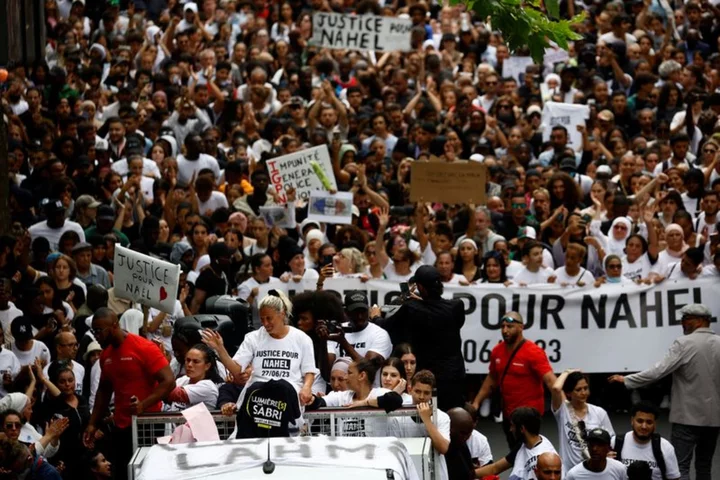PARIS Defiant gatherings were held outside town halls across France on Monday following a wave of rioting triggered by the fatal police shooting of a teenager of north African descent.
Here is some key information about the unrest:
WHERE ARE THE RIOTS?
There was very little rioting overnight on Sunday and police made fewer than 160 arrests. The previous flashpoints have included the Parisian suburbs, Lyon, Strasbourg, Metz, Nice, Toulouse, St Etienne and Tours.
IS IT SAFE TO TRAVEL IN FRANCE?
As of July 3 the UK government advises only that Britons in France "avoid areas where riots are taking place, check the latest advice with operators when travelling and follow the advice of the authorities." It does not warn against visiting any specific towns or cities.
The latest alert from the U.S. embassy in Paris related to the rioting was posted on June 29, with the advice that "U.S. citizens should avoid mass gatherings and areas of significant police activity". It also did not warn against visiting any specific places.
WHO WAS THE TEENAGER KILLED BY POLICE?
The 17-year-old who died last Tuesday has been identified only as Nahel. His mother is Algerian and father Moroccan, according to an acquaintance of the family. He was known to police for previous incidents in which he failed to comply with traffic stops, the local prosecutor Pascal Prache said.
Nahel died from a single shot through his left arm and chest. Police and paramedics tried to resuscitate him but he was declared dead at 9:15 a.m., Prache added.
An officer has acknowledged firing a lethal shot, the prosecutor said, telling investigators he wanted to prevent another chase, fearing he or another person would be hurt.
WHAT HAPPENED AT THE TRAFFIC STOP?
Prache said police spotted a Mercedes driving in a bus lane at 7:55 a.m. in the district of Nanterre on the western outskirts of Paris. Police attempted to pull him over at a red light using sirens and lights, the prosecutor added.
But Nahel disobeyed and committed several traffic offences, endangering the lives of a pedestrian and a cyclist.
The officers caught up with the Mercedes in a traffic jam. Both officers at one point used guns to deter him from starting off again and asked him to turn off the ignition, the prosecutor said. When the car made to get away, one officer fired at close range through the driver's window.
WHY DID RIOTS UNFOLD?
Nahel's death has fed longstanding complaints of police violence and systemic racism inside law enforcement agencies from rights groups and within the low-income, racially mixed suburbs that ring major cities in France. Authorities deny that.
Even though the police officer involved is under investigation for voluntary homicide and President Emmanuel Macron has condemned the shooting, public anger has spilled onto streets across France. Police made 180 arrests during a second night of unrest into Thursday. Some 40,000 officers were deployed to curb the trouble, 5,000 in the Paris region.
The killing was the third fatal shooting during traffic stops in France so far in 2023, down from a record 13 last year. The majority of victims of such shootings since 2017 were Black or of Arab origin.
WHAT IS THE HISTORY OF SUCH UNREST?
Like the United States and some other European nations, France has experienced previous waves of protests over police conduct, particularly against minorities.
In 2005, violence erupted in the Paris suburb of Clichy-sous-Bois and spread across France after two teenagers of African descent were electrocuted in a power substation as they hid from police. That unrest convulsed France for three weeks and forced then President Jacques Chirac to declare a state of emergency.
(Writing by Richard Lough; Editing by Andrew Cawthorne and Hugh Lawson)

